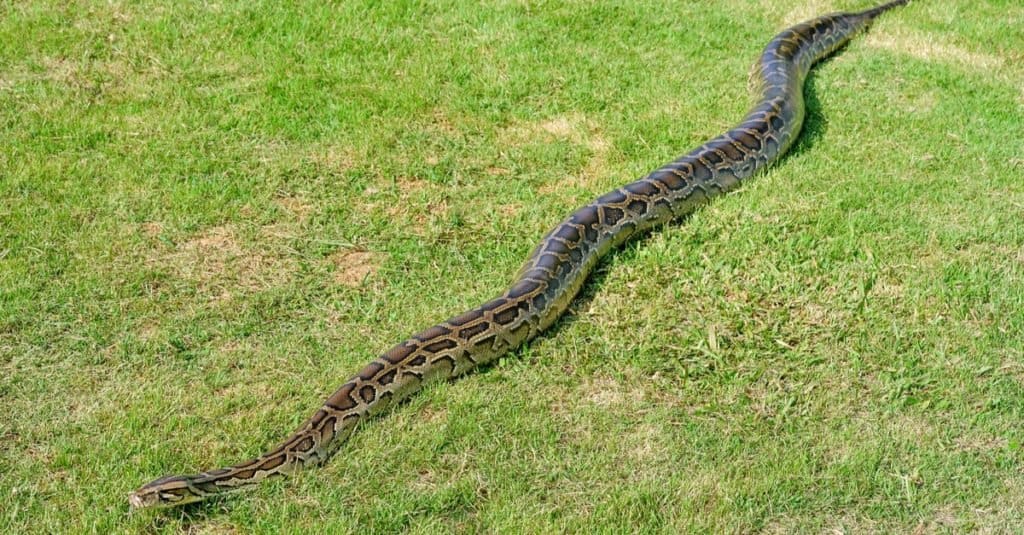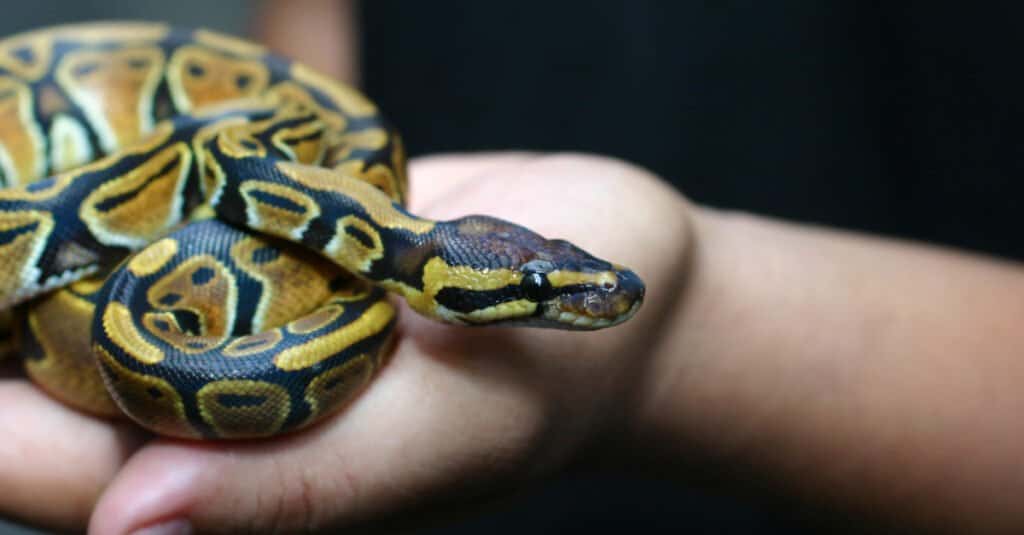The vast majority of snakes are less than five feet long, but some breeds grow beyond that measure. In fact, some snakes, like the largest anaconda, are almost mythological in their proportions. While you will find many stories about snakes that measure over 100 feet in length and have fought military groups to a standstill, those stories are false. In some ways, the real largest python ever to live is more interesting, and it was alive not all that long ago. Let’s take a closer look at this large reptile and show you how it compares to other massive snakes and whether it’s dangerous.
What is the Largest Python to Ever Live?

The Reticulated Python is one of the snakes very popular with expert reptile keepers.
©Opayaza12/Shutterstock.com
The largest python to ever live was about 26.25 feet long (8 meters) and weighed about 550lbs (250kg). This massive reticulated python was caught in Malaysia in 2016. It was discovered at a construction site. Unfortunately, the snake, which had recently laid eggs, died days after it was captured.
The other largest python to ever be found and kept in captivity is called Medusa. This snake is also a reticulated python, the species that seems to break all the records. Medusa measures 25.2 feet (7.67 meters) and weighs 350lbs (158.8kgs).
This snake is much smaller than the one that was found in Malaysia. Unfortunately, the snake’s size was never confirmed and recorded, so it might be hard to consider that one the largest python to ever exist. Even so, we have to wonder just how large these snakes can get in the wild if such a large species was just stumbled upon by humans.
What is the Biggest Python Species?

Burmese
pythons are more massive than reticulated pythons.
©Yatra/Shutterstock.com
Reticulated pythons are the biggest python species. Several of these snakes have been confirmed lengths over 25ft and possibly over 30ft. New estimates based on old skin sheds seem to indicate that humans may have underestimated the length of snakes from the past.
Moreover, we have two cases, Medusa and the unnamed snake from Malaysia above, where the snake was longer than any accurately documented snakes of any type. However, it might be more precise to say that the reticulated python is the longest.
The Burmese python is the most massive snake that has ever been reliably kept in captivity. One Burmese python named Baby grew to a mass of 403lbs, far heavier than any reticulated python on record. Baby reportedly measured just under 19 feet long. Again, we must consider the fact that the Malaysian reticulated python may not have been properly measured.
Given these two circumstances, we can accurately say that the reticulated python is the longest and it might just be the biggest, too.
How Does the Largest Python Measure Up to Titanoboa?

The Titanoboa would probably eat the average time-traveling tourist.
©Michael Rosskothen/Shutterstock.com
When we are talking about the massive, nearly mythical snakes that roam the earth today, it’s impossible not to compare them to gigantic snakes from the past. These creatures were much larger and developed after the reign of dinosaurs had ended.
The Titanoboa was a long, massive snake that grew 40-50 feet in length and weighed over 2,500lbs. According to the fossil records, this snake lived in what is now northern Colombia. That area was lush with plant life and may have been the first tropical rainforest in this part of the world.
The Titanoboa is larger than any snakes living today that humans have found and measured. Perhaps the closest snake in terms of thickness and length would be the green anaconda. The largest verified anaconda size is 215 pounds and about 17 feet long.
Though not confirmed, the largest anaconda was supposedly found in Brazil, measured 33 feet long, and weighed 880lbs. Unfortunately, this snake died as a result of the excavation in the area. However, it’s safe to say that the anaconda is the closest thing we have to snakes as large as Titanoboa these days.
Are Pythons Dangerous?

Many pythons are too small to be dangerous to people.
©BikerPhoto/Shutterstock.com
Pythons are dangerous, but we have to remember that danger is relative. The average person isn’t threatened by a ball python. However, large variants of these snakes certainly pose a danger to the animals that share their habitat.
Part of the danger comes from their size and also the way that they kill their prey. Unlike venomous snakes, pythons use their entire bodies to attack their foes. They will wrap around them and squeeze until the prey dies of organ failure or cannot breathe.
Pythons are also dangerous when they are left to their own devices and allowed to reach massive sizes. For example, the Burmese python has invaded parts of Florida, and it has no natural predators in that area. Thus, they pose an incredible amount of danger to the creatures in that area like deer and alligators. Yet, no records exist of these particular snakes trying to kill humans.
Still, the thing about these snakes that increases their potential to be dangerous is that they have a willingness to pursue prey that is much larger than themselves. For instance, an Australian woman was attacked in her sleep by a scrub python. The snake attempted but failed to eat her, showing little fear that it was going up against an unfamiliar prey as well as one that was so large.
All in all, pythons are dangerous, but they are rarely dangerous to cautious people.
Where Do Pythons Live?

Humans keep pythons as pets around the world
©Krisda Ponchaipulltawee/Shutterstock.com
As we have already mentioned, pythons have made their home in Florida in the U.S. They are particularly well-established in the Florida Everglades. However, these snakes also live in a lot of different places around the world.
Burmese pythons and many others live in Southeast Asia. Pythons are also found in Australia and Africa. When you count the places where they are kept as pets, we can confidently say that pythons live in many places throughout the world.
Pythons are very unique snakes. Some species make for great pets that are willing to be handled and are more docile than other snakes. The fact that they don’t make venom and that many of them are less than 3 feet in length is even better.
Unfortunately, improperly housing these snakes or dumping them when they get too big for their enclosures is common practice. That’s how these animals turn from cool pets into invasive species. Anyone that is going to get a pet snake needs to learn how to properly care for them and how to get help if they become too much to handle.

Pet pythons begin a diet of mice and can be fed rats and eventually rabbits as they grow.
©Firman Wahyudin/Shutterstock.com
Lifespan: How Long Do Pythons Live?
Most pythons live a long life. The average lifespan for a python, if it survives into adulthood, is 15-20 years in the wild. But in captivity, they can live even longer. A ball python lived 48 years in a zoo! If you’re looking to adopt a python for a pet, make sure you are willing to commit several years to its care.
The photo featured at the top of this post is ©
Discover the "Monster" Snake 5X Bigger than an Anaconda
Every day A-Z Animals sends out some of the most incredible facts in the world from our free newsletter. Want to discover the 10 most beautiful snakes in the world, a "snake island" where you're never more than 3 feet from danger, or a "monster" snake 5X larger than an anaconda? Then sign up right now and you'll start receiving our daily newsletter absolutely free.
Thank you for reading! Have some feedback for us? Contact the AZ Animals editorial team.







